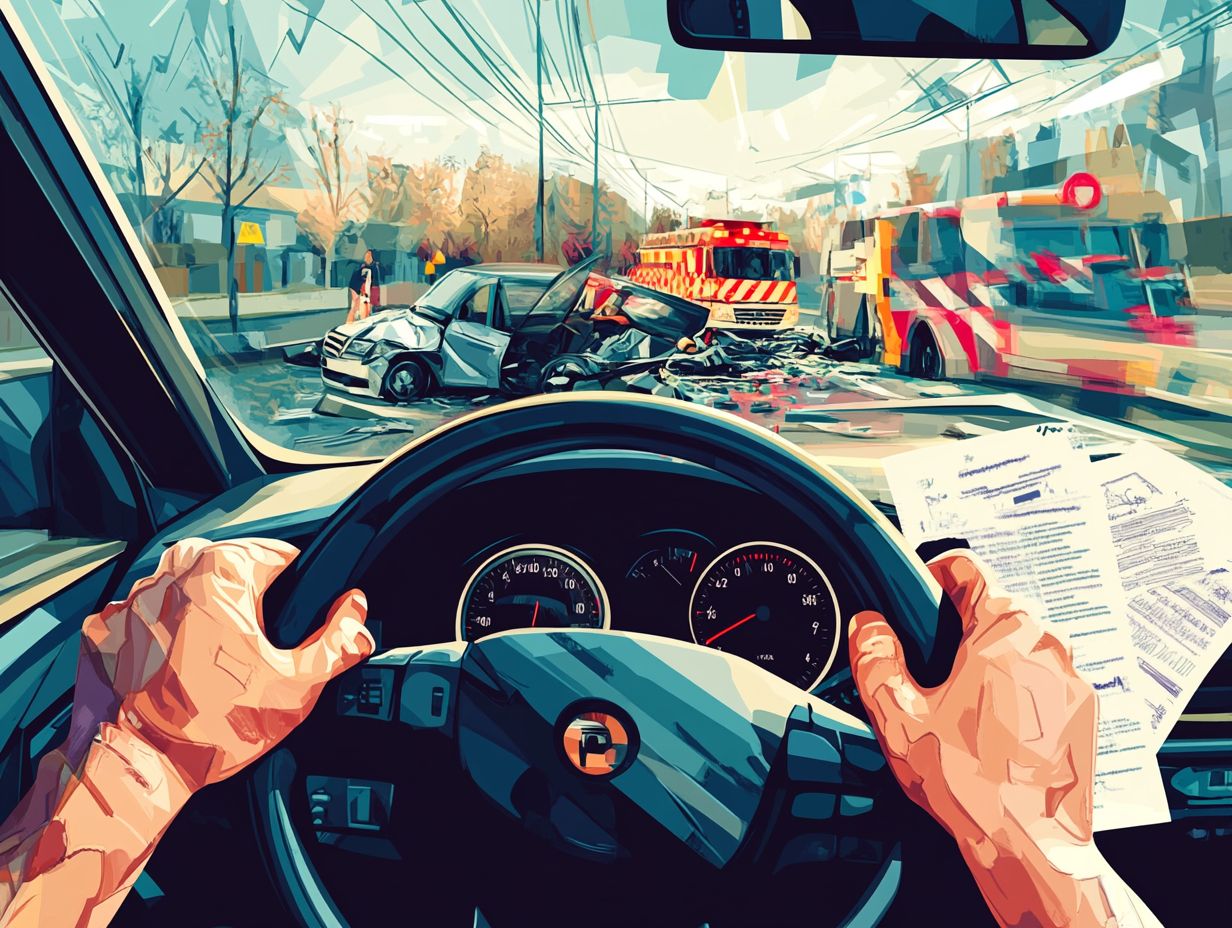What Is a High-Risk Driver and Who Qualifies?
Understanding high-risk driving is crucial for everyone. It plays a key role in road safety.
This article explores what defines a high-risk driver, the common factors that contribute to risky behaviors, and who fits into this category. It also discusses the significant repercussions of being labeled a high-risk driver, including impacts on insurance rates and driving privileges.
You will find practical tips for improving your driving record and valuable resources to assist you on this journey.
Let s dive into this topic in depth!
Contents
Key Takeaways:

- High-risk drivers show risky behaviors, like speeding or driving under the influence. Understanding this can help you stay safe on the road!
- Factors like age, driving record, and vehicle type can contribute to high-risk driving. Common causes include distracted driving and aggressive behavior.
- Anyone with a history of traffic violations, accidents, or driving under the influence (DUIs) can qualify as a high-risk driver. Insurance companies use specific criteria to classify individuals as high-risk.
Understanding High-Risk Drivers
Understanding high-risk drivers is essential for you, whether you’re an insurance company or a policyholder, as they present distinct challenges in the auto insurance landscape.
A high-risk driver often has a bad driving record. This includes issues like drunk driving or many accidents. These behaviors can lead to increased insurance premiums, highlighting the necessity of grasping this classification within the insurance industry.
Definition and Characteristics
High-risk drivers are individuals whose histories feature multiple traffic violations, such as reckless driving and DUI convictions. This leads insurance providers to classify them as high-risk.
This classification significantly affects their insurance costs, often resulting in higher premiums compared to safer drivers. However, the implications of being labeled as high-risk go beyond just financial burdens; maintaining a clean driving record becomes essential for anyone in this situation.
Each infraction can lead to additional complications, including increased restrictions on driving privileges and greater difficulty in securing affordable insurance coverage. Therefore, it is crucial for those in this category to adopt safer driving habits.
By improving their records, they not only stand to benefit from better future premiums but also contribute to enhanced road safety for everyone.
Factors That Contribute to High-Risk Driving
Several factors contribute to high-risk driving, each significantly influencing your auto insurance rates and coverage options. A history of auto accidents, driving violations, and a poor claims history can all play a crucial role in determining your premiums.
Insurance companies carefully assess these elements to evaluate the risk of insuring you, often resulting in higher costs for those with a less-than-stellar driving record.
Common Causes of High-Risk Behavior
Common causes of high-risk behavior on the road include frequent auto accidents, traffic violations, and serious offenses like driving under the influence (DUIs), which can have a significant impact on your classification as a driver.
Such reckless actions often arise from poor decision-making, whether it’s choosing to get behind the wheel after consuming alcohol or driving aggressively in a rush. Reckless driving not only jeopardizes your safety but also endangers the lives of others, leading to collisions and property damage. Driving under the influence impairs your judgment and coordination, further heightening the risk of accidents.
Together, these behaviors create a troubling image of a driver who may be perceived as irresponsible and unaware, resulting in higher insurance premiums and potential legal repercussions.
Who Qualifies as a High-Risk Driver?

To qualify as a high-risk driver, you must meet certain criteria established by insurance companies. These criteria typically emphasize classifications that suggest a greater likelihood of causing auto accidents.
Key factors in this evaluation include your history of traffic violations and the severity of any past incidents. Your overall insurance history also plays a crucial role in determining your risk profile and ultimately your insurance rates.
Criteria for Classification
Insurance companies look at various factors to identify high-risk drivers. They consider your driving experience, traffic violations, and how well you manage your insurance premiums.
Other essential elements include your credit score and the frequency of claims you’ve made in the past. The type of vehicle you drive is also important. For instance, a history of late payments may lead to concerns about your reliability in meeting financial obligations.
Your geographical location matters too. Areas with high accident or theft rates can affect your risk evaluation. By analyzing these factors comprehensively, insurers can more accurately determine your premium costs and the availability of coverage.
Consequences of Being Labeled a High-Risk Driver
Being labeled a high-risk driver comes with serious consequences. It can significantly affect your insurance rates and driving privileges.
If you find yourself in this category, you’ll likely encounter higher premiums. You may also face a more restricted selection of insurance coverage options due to your claims history.
Impact on Insurance Rates and Driving Privileges
High-risk classification can lead to steep insurance rates. You may also face the risk of losing your driving privileges due to repeated incidents.
This classification strains your finances with inflated auto insurance quotes and limits your access to favorable coverage options. Insurers may set tougher rules, making it challenging to secure essential insurance.
As a result, you might find yourself in a difficult situation either accepting those high premiums or risking legal trouble by driving without adequate coverage. This scenario can keep you labeled as high-risk.
It’s crucial to explore ways to improve your situation, such as enrolling in defensive driving courses or looking into specialized insurance programs.
How to Improve Your Driving Record
Improving your driving record is essential for lowering your insurance costs. You can achieve this by enrolling in defensive driving courses or adding the latest safety features to your vehicle.
The sooner you act, the sooner you can get back to enjoying lower premiums!
Tips for Avoiding High-Risk Driving Behaviors

To avoid high-risk driving behaviors, you should implement strategies like driving safely by paying attention to others, keeping a clean driving record, and utilizing vehicles with advanced safety features.
These approaches can significantly enhance your road safety and reduce the likelihood of accidents. Driving safely by paying attention to others involves vigilant observation of road conditions and anticipating the actions of other drivers, giving you the power to react swiftly to potential hazards. For instance, by maintaining a safe following distance and regularly checking your blind spots, you can better prepare for unexpected maneuvers from surrounding vehicles.
A clean driving record demonstrates responsible behavior and can lead to lower insurance premiums, providing an added incentive to prioritize safety.
Also, driving modern vehicles equipped with advanced safety features such as automatic braking systems and lane departure warnings can further protect you against reckless driving.
By merging these methods, you cultivate a culture of responsibility that promotes a safer driving environment for everyone on the road.
Resources for High-Risk Drivers
As a high-risk driver, you have access to a wealth of resources tailored to enhance your driving habits and potentially reduce your insurance premiums. This includes expert guidance from insurance providers and comprehensive educational materials focused on financial responsibility.
By leveraging these tools, you can take proactive steps towards safer driving and more favorable insurance rates.
Support and Assistance for Improving Driving Habits
High-risk drivers have exciting opportunities to improve their skills through defensive driving courses! These courses not only sharpen your driving abilities but can also qualify you for insurance discounts and enhance your financial responsibility.
These programs educate you about safe driving practices, noticing potential dangers on the road, and the importance of maintaining a calm mindset while behind the wheel. You ll find a wealth of resources available, from online modules to in-person workshops, providing the flexibility you need to fit these courses into your busy schedule.
Many insurance companies appreciate the commitment you show by completing such courses and may reward you with incentives, helping to lighten your financial burden. Community organizations frequently offer supportive workshops aimed at fostering better driving habits and encouraging your personal development while cultivating a culture of safety on the roads.
Frequently Asked Questions
What Is a High-Risk Driver?
A high-risk driver is someone more likely to be involved in accidents or have traffic violations based on their driving history, age, or other factors. This can result in higher insurance premiums and possibly being denied coverage by some insurance companies.
Who Qualifies as a High-Risk Driver?

There is no set criteria for who qualifies as a high-risk driver, as it can vary among insurance companies. However, common factors that may classify someone as high-risk include having multiple speeding tickets, at-fault accidents, DUI or DWI convictions, or being a newly licensed driver.
How Does Being a High-Risk Driver Affect Insurance Premiums?
Being classified as a high-risk driver can significantly impact your insurance premiums. Insurance companies may see you as a greater risk to insure and, therefore, charge higher rates to offset that risk. This can lead to paying hundreds or even thousands of dollars more for coverage.
Can High-Risk Drivers Still Get Insurance?
Yes, high-risk drivers can still get insurance, although it may be more difficult and expensive. Some insurance companies specialize in providing coverage for high-risk drivers, but be prepared to pay higher premiums and possibly have limited coverage options.
Take the first step towards safer driving today!
How Long Does Someone Stay Classified as a High-Risk Driver?
The length of time someone is a high-risk driver can vary. Typically, it ranges between 3 and 5 years.
This varies by state and insurance company. You can improve your chances of being classified as a standard driver again by avoiding accidents and tickets.
How Can High-Risk Drivers Improve Their Insurance Rates?
High-risk drivers have exciting opportunities to lower their insurance rates! Maintaining a clean driving record, taking a defensive driving course, and boosting your credit score can all help.
Shopping around and comparing rates from different insurance companies can help you find better deals.





